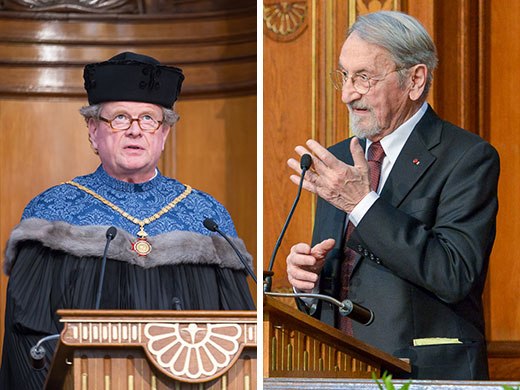Martin Karplus, Prof. Dr.
Honors
| Ehrung | Titel | Datierung | Fakultät | |
|---|---|---|---|---|
| Honorary Doctorate | Dr. phil. h.c. | 2014/15 | Faculty of Chemistry |
|
- Faculty of Chemistry
When Martin Karplus was awarded the Nobel Prize in Chemistry in 2013, he was asked to describe his work in simple terms. “If you like to know how a machine works, you take it apart,” he said. “We do that for molecules.” In fact, Martin Karplus created the basis for computer-aided modelling of chemical processes that is now essential to understanding biomolecules such as proteins, DNA, RNA, and cell membranes.
Vienna was the first stop on his lifeʼs journey, but his departure from his hometown was not voluntary: after the “Anschluss” of Austria in 1938, the family fled first to Switzerland and then to the United States, where they built a new life in the Boston area. Contrary to the family tradition – both grandfathers were physicians, including the neurologist Johann Paul Karplus, a professor at the University of Vienna – Martin Karplus did not pursue a career in medicine. He was interested in the biological processes that underlie life and soon realized that these could only be understood in terms of the chemical and physical processes involved. He developed an approach that transcended the boundaries between disciplines and brought them together.
After completing his Ph.D. at the California Institute of Technology under the supervision of the future two-time Nobel laureate Linus Pauling and a postdoctoral fellowship at Oxford, Karplus received his first academic appointment at the University of Illinois. In 1959, he developed the “Karplus equation” named after him, which made it possible for the first time to derive the spatial structure of molecules from data obtained by nuclear magnetic resonance spectroscopy. After a stint at Columbia University, Martin Karplus returned to Harvard in 1966. There he devoted himself to developing models for studying the molecular dynamics of biological processes. Martin Karplus was the leader of the team that carried out the first molecular dynamics simulation of a biomolecule in 1976. His computer program Chemistry at Harvard Macromolecular Mechanics (CHARMM), published in 1983, continues to be developed and used until today, including at the Institute of Computational Biological Chemistry at the University of Vienna.
In 2013, Martin Karplus shared the Nobel Prize in Chemistry with Arieh Warshel and Michael Levitt for his pioneering contributions to the development of multiscale models of complex chemical systems. In 2015, the Republic of Austria honored him with the Austrian Decoration of Honor for Science and Art, and the University of Vienna awarded him an honorary doctorate on the initiative of the Faculty of Chemistry. A selection of travel photos of the passionate photographer were also exhibited on this occasion. In August 2024, Martin Karplus was awarded the Grand Decoration of Honor in Gold for Services to the Republic of Austria, one of the countryʼs highest honors.
The theoretical chemist, Nobel laureate, and honorary doctor of the University of Vienna died on December 28, 2024, at the age of 95. He left a scientific legacy that has profoundly influenced modern chemistry.
Zuletzt aktualisiert am 04/10/25
-

Dekan Bernhard Keppler als Laudator (links) und der Chemiker und Nobelpreisträger Martin Karplus (rechts) bei der Verleihung des Ehrendoktorates der Universität Wien 2015
Bernhard Keppler, Dekan der Fakultät für Chemie (links), bezeichnet in seiner Laudatio den Chemiker und Nobelpreisträger Martin Karplus als "...

